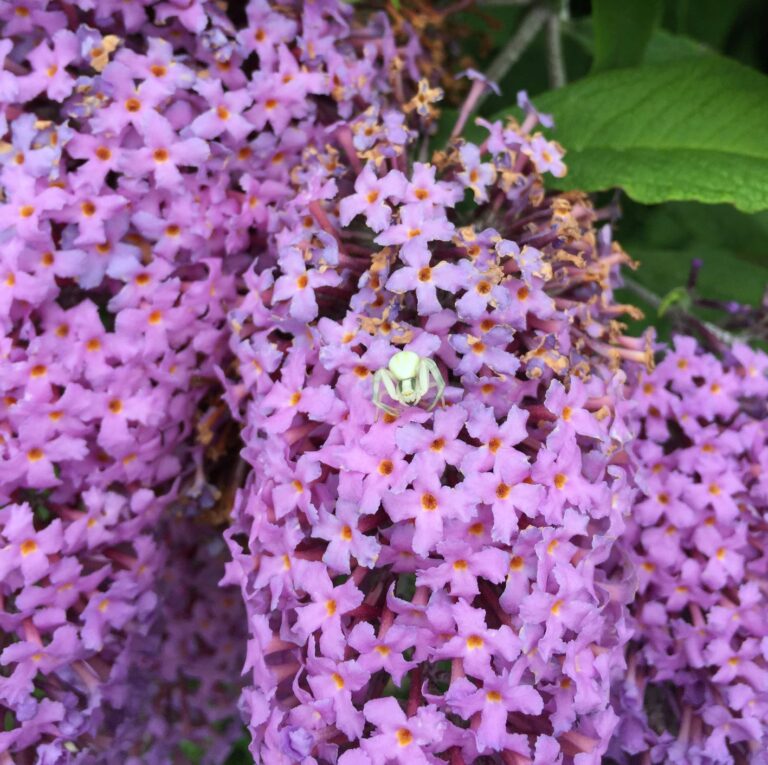
The Little Sounds of Every Day
You should be interviewing roses, not people.
—Anne Carson
Noisy Flowers
My mother was alone by herself in the sitting-room when a strange creaking sound caught her ear. What was it? She paused to listen more carefully, and realized that what she’d heard was the sound of a hyacinth growing: its close-packed blossoms stretching, and its glossy leaves. It made a sharp juicy noise, she said.
In the Japanese classic, The Book of Tea, Okakura Kakuzo writes that such “noisy” flowers were relentlessly banished from the tea room. Tranquility was paramount. But most of us, I think, would be intrigued to hear such Lilliputian sounds. When Elisabeth Tova Bailey was laid low by a mysteriously virulent illness, a friend presented her with a white-lipped forest snail which took up residence in her pot of violets. First, “a petal started to disappear at a barely discernible rate,” and then, as Bailey listened, she could hear it eating. “The sound was of someone very small munching celery continuously.” For an hour she lay back against her pillow, transfixed by the minuscule munching of an entire purple petal.
Bailey remained bedridden for several years, “too weak to hold a book, too ill to sit up to watch a film.” Though she longed for human visitors, she didn’t have the energy for conversation. Meanwhile the snail (by then transferred to a terrarium), “kept [her] spirit from evaporating.” She observed it at intervals throughout the day, enjoying its miniature companionship. “Watching another creature go about its life… somehow gave me, the watcher, purpose too.” Little by little, she compiled her findings into a magical small book. The Sound of a Wild Snail Eating was first published in 2010, and has since won several prizes, including the John Burroughs Medal Award for Distinguished Natural History. Bailey’s prose is lucid and informative, deeply researched, and alive with richly detailed observation. It is as if, in befriending the snail, she had herself come to possess the “keen vision and feeling of all ordinary human life” that George Eliot describes in Middlemarch, freed to hear “the grass grow and the squirrel’s heart beat” — and of course to attend to the gnashing of innumerable small teeth.
Listening Out
Poets and writers, naturalists and mystics are, many of them, gifted and attentive listeners, though few have Bailey’s dazzling singularity of focus. “Listen, listen, I’m forever saying,” writes the poet Mary Oliver,
Listen to the river, to the hawk, to the hoof,
to the mockingbird, to the jack-in-the-pulpit —
William Stafford, too, draws attention to the almost inaudible sounds of every day, encouraging us to “listen out” in ever-widening circles.
My father could hear a little animal step,
or a moth in the dark against the screen,
and every far sound called the listening out
into places where the rest of us had never been.
“I wanted to be a listener,” writes the blind poet Stephen Kuusisto. “And by this I meant I wanted to be a happy man.”
As a boy, Kuusisto had a deep affection for the radio. He’d wake up early every Sunday to listen to a program about birds, hosted by an elderly ornithologist. “The purple finch sounded more contented than any creature I knew of … [Its] notes were round and quick as pins dropping on a glass table.” Alone in the woods, he might spend an entire hour listening to a single bird. Soon he realized that he could in fact stop anywhere — stop and listen — and the story of the neighborhood would open up around him.
The ordinary street outside our suburban house was surprisingly beautiful with all its fractions of living … A car slid by with its windows rolled down and a radio voice said, “You can whip them into shape with …” And then the car was out of hearing range, the voice dwindling into fuzzed vocables … I stood still and a man’s voice came from across the street — there was a sound of something heavy and metallic dropped on concrete. “That’s the end of that,” I heard him say. He was a man with a trash can.
Kuusisto’s sense of equivalence, his refusal to privilege birdsong over the radio voice or the man with the trash can, encourages the reader to suspend such judgment too. “Pablo Neruda heard the salt singing in the shaker,” he reminds us. “Franz Liszt heard apples muttering in a wicker basket … Whitman … could reconstruct a whole day from sounds remembered in sequence.”
Meanwhile, Kuusisto continues to practice listening wherever he finds himself, treating each new sound-encounter as a kind of music. Standing in the cavernous lobby of a hotel, he locates the escalators by means of their hum, followed by “the whisper of rolling metal, a feverish sound.” “If you’re blind,” he says, “you need to make hearing as pleasurable as sight-seeing … open all the time to lucky possibilities in the soundscape.”
Listening to the Onions
When I ask Alice Cozzolino to name her favorite sounds, she comes up with a long list, starting with “any kind of bird call,” and moving on through frogs and crickets and squirrels to “the wind in the trees, and water dripping, flowing.” She loves interior sounds as well, “almost any sound in the kitchen, even the clanging of pots; spoons against the rim; pouring pasta in a colander, and hearing the water gush and then slowly trickle through the small holes into the sink; the sound of food sautéing in hot oil.”
Cozzolino is in her sixties now, a sturdy, handsome woman with a mane of long grey hair and warm brown eyes. She lives in western Massachusetts with her partner, Amy, and runs a food delivery service called “Alice’s Kitchen.” She also teaches regular cooking classes. “Come to your senses!” she tells her students. “Come to your senses in my kitchen!”
Listening to food is something Cozzolino discovered for herself. “No one ever taught it to me,” she says. “I never read of it.” But as she became more centered in her daily life — “in terms of taking a breath, stopping, paying attention” — she found ways to translate that meditative practice into the act of cooking. As we speak, she talks me through the preparations for an imagined meal.
“Listen to the onions now,” she says. “That oil is hot, so listen to the sound of the onions hitting the hot oil. If it doesn’t sizzle, the oil isn’t hot enough. Smell what that smells like. There’s an acridness, a sharpness.” And then, once some time has passed, “Now listen to the onions. They’re juicy! It’s going shlllshh-shllssh! It’s a wet sound, where before it was dry. Smell the onions. It’s a rounder aroma, it’s not sharp, it’s round. Look! It’s reduced in volume from six cups to three.”
She explains that the acids transform the sugars in response to the heat, changing the molecular structure, and the flavor too, from acrid to sweet. Soon after that, the onions will begin to stick. A less experienced chef might reach for a wooden spoon, and start to stir. But from Cozzolino’s point of view, that would be a mistake. “There’s a French term called the fond, and the fond is treasured,” she says. “If you add any acidic ingredient — dry sherry, or a little splash of vinegar, or some lemon juice — the acid will react with the fond, and it will be released from the pan, creating a richly-flavored dark brown gravy.”
I ask Cozzolino how she might teach someone else to cook like this. “It’s very tricky,” she says, “because it has to do with actively choosing to surrender, which is an oxymoron.” The challenge is to bring her students back to center, returning them to their senses, time after time. “Touch the food,” she tells them. “What does it feel like? What does it look like? What do you smell?” She might do that three times in a minute. Again and again, that same gentle, persistent reminder. “Taste. Smell. Look. Listen. Over and over and over and over.”
Such concentrated focus does not come easy, even for Cozzolino. “Listening takes quiet,” she says. “It takes time. You can’t listen quickly.” She quotes research that emphasizes the growing impatience of most western consumers, “the addiction to the instantaneous.” From her point of view, “that’s the antithesis of listening. Listening requires us to take a breath. It requires us to pause.”
Cozzolino’s partner, Amy Pulley, is especially skilled at this. The two have been together for more than forty years, but even now Cozzolino responds to her with loving wonderment. “My beloved Amy, who will allow the act of listening to supersede in importance anything else around her.” She describes how Pulley’s head cocks to one side as she listens, eyes wide open, gazing deeply inwards. “Whoa, what is she looking at?” asks Cozzolino. Watching Pulley has taught her just how crucial that listening can be.
In the words of the writer, Mark Nepo, “Patience, the art of waiting, is the heart-skill that opens the world.”
Footnotes
Noisy Flowers
Back in summer 2015, strange popping sounds were reported in some British gardens. A cool early June followed by a sudden hot spell had led to so-called “cauliflower creak” — the sound of the cauliflower florets rubbing together as they grow — the loudest outbreak in a quarter century. The Week, July 4th, 2015.
“There are sounds also in the realm of vegetation. In Israel, Great Britain, and the US, photo-acoustic spectroscopy has been used to make the sound of a rose audible at the moment when the bud bursts into blossom: it is an organ-like droning, reminiscent of the sounds of a Bach toccata or Messiaen’s Ascension for organ… a spread succession of chords.” Joachim-Ernst Berendt, The World Is Sound: Nada Brahma: Music and the Landscape of Consciousness (Destiny Books, 1987).
“noisy flowers…” Okakura Kakuzo, The Book of Tea.
“a petal started to disappear…” etc. Elisabeth Tova Bailey, The Sound of a Wild Snail Eating, (Algonquin Books, 2010).
“keen vision and feeling of all ordinary human life…” George Eliot, Middlemarch.
Listening Out
“Listen, listen, I’m forever saying…” Mary Oliver, “Stars.”
“My father could hear…” William Stafford, “Listening,” West of Your City (Talisman Press 1960).
“I wanted to be a listener…” etc. Stephen Kuusisto, Eavesdropping: A Memoir of Blindness and Listening (W.W. Norton, 2006).
Listening to the Onions
Alice Cozzolino, interviewed by Christian McEwen, November 9th, 2014.
Not long ago, I heard Molly Birnbaum and Dan Sousa interviewed on National Public Radio. They had just published an article called “Taste With Your Ears: How Sound Can Change The Way We Eat” which Cozzolino would have loved. It taught people to distinguish between “the very soft, almost muffled” sound of hot water being poured into a mug, and the “much crisper” sound of cold water, and helped them attend to the “really sharp sizzle” of a perfectly butter-basted rib-eye steak.
Allison Aubrey, National Public Radio: December 24th, 2016.
“‘Whenever you’re doing something with awareness, it’s a two-way street: things talk back to you…’ Cooking, she says, is a wonderful opportunity to observe — the food, yourself, and the magic that can happen between the two.” Laura Fraser quoting Deborah Madison, “The Joy of Mindful Cooking,” The Best Buddhist Writing 2010, edited by Melvin McLeod (Shambhala, 2010).
“Patience, the art of waiting…” Mark Nepo, Seven Thousand Ways to Listen: Staying Close to What is Sacred (Simon & Schuster, 2012).
Christian McEwen is a freelance writer and workshop leader, originally from the UK. She is the author of several books, including World Enough & Time: On Creativity and Slowing Down, now in its seventh printing. Her latest book is Legal Tender: Women & the Secret Life of Money. She is currently working on a book called In Praise of Listening, from which these excerpts are taken. www.christianmcewen.com

